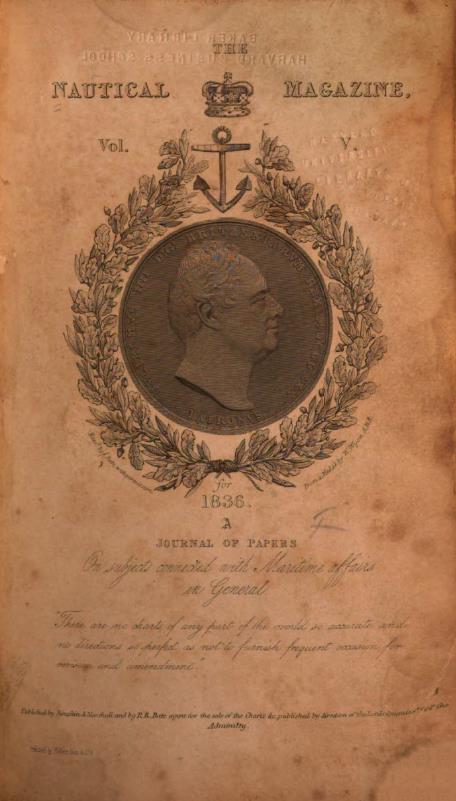|

|
. . . .
Remarks on Some of the Galapagos Islands.
By Mr. R. C. Allan, R.N. H.M.S. Conway, Saturday, Nov. 1, 1834—At 7 h. a.m. made the land, Charles Island bearing N. by W. ½ W. Current set during the night to the N. W. about one mile and a half per hour. At 8 h. 30 m. saw Gardner Island, and at 9 h. 30 m. Caldwell Island, both small islands. At noon Charles Island (centre) N.N.W. distant twelve miles. Lat. by observation 1°34'S. Charles Island.—No landing apparently on the south side of the island. Rounded Saddle Point at the distance of three miles; steered direct for the west point of Post-office Bay; no bottom with fifteen fathoms the whole way; ship going six knots; rounded the last-mentioned point at the distance of half a mile; saw Albemarle and Duncan§ islands. At 5 h. 30 m. p.m. anchored in Post-office Bay, in seven fathoms, sandy bottom.
On the east side of the bay are several small, flat, rocky islets, off which a shoal extends a short distance, and has three fathoms and a half. This is a snug smooth anchorage, but there is nothing to be obtained. Monday, Nov. 3.—Shifted our berth to Black-Beach Bay, on the west side of the island, about six miles N.N.E. from Saddle Point. |
Latitude of the anchorage, 1°14' S.; longitude, by chronometer, 90°8' W., var. 9° Easterly. The tides are irregular; rise and fall about twelve feet. The settlement cannot be seen by a vessel running past; it is situated about five miles inland, between two of the highest mountains. Water is scarce. Nov. 4, 1834.—At 2 a.m. sailed from Charles Island, and steered north and N. by E. for Duncan [sic, Indefatigable] Island. At daylight a group of small islands on our larboard beam. Crossman Island.—This island is not laid down in its proper position on Colnett's chart; its south end is in 0°37' south latitude, and it is about ten miles to the southward and westward of Duncan Island [sic, Indefatigable]. There is deep water all round, and it has no harbour; but there is anchorage for vessels drawing twelve or thirteen feet in a small creek on the north side of the island. It appeared bluff and barren on all sides. The length of the island is about eight miles.§ Bewel Rock. About six or seven miles to the S.E. of Crossman [sic, Pinzón] Island is a remarkable rocky islet called Bewel Rock [ie, Sin Nombre], being near 150 feet high, and of a conical shape; it lies three or four miles off Duncan [sic, Indefatigable] Island, and is steep to all around. Duncan Island. At 10 a.m. we sent our boats on shore on the south side of Duncan [sic, Indefatigable] Island, to procure terrapin and turtles, and we then steered for the anchorage on the N. W. end of the island, keeping mid-channel between Bewel Rock and Duncan Island, and then direct for the N.W. end of the island, where we brought up at 1 p.m. In the later charts of these islands, this has been called Indefatigable Island; Duncan is its original name.§ We found good anchorage in Duncan Bay, which is on the N.W. end of the island; it is formed by a group of small islands on the north [Islas Guy Fawkes], by the island on the east, and on the south by a high rocky island or islet.
in 7 1/2 fathoms sand. Two ship's length inshore of this berth is the outer edge of a flat extending out from the beach. Vessels sailing into this bay should take in their light sails, as very strong puffs of wind frequently blow over the land. There are two reefs of rocks extending off the south side of the island, which should not be approached nearer than two miles by strangers. There is good |
landing for boats, and an abundance of terrapin and turtles may be procured. Wednesday, Nov. 5, 1834. At six a.m. sailed from Duncan [sic, Indefatigable] Island, and stood to the westward, with a brisk wind from S.S.E. Passed Jervis Island on its south side, two miles distant. Jervis Island. In Capt. Colnett's Chart of the Galapagos Islands, this island is laid down North of Duncan Island, and in the latest charts it has been omitted. Duncan Island has been named Duncan and Jervis Island§, Jervis Island not being found in the position assigned to it by Capt. Colnett. Jervis Island lies three or four miles south of James Island, and it is about four [sic, less than two] miles in length; there is anchorage on the N.W. side of it, where whale-ships sometimes refit. Ships may anchor here, and send their boats straight over to James Island for terrapin and turtles, there being no anchorage on the south side of the latter island. James Island. The passage between James and Duncan Islands is interspersed with numerous rocks and small islands, and should not be attempted. Having passed Jervis Island, we hauled up for James Island; kept within a mile of the shore, no bottom with twelve fathoms: hove-to in the harbour [James Bay]; latitude of ditto, 0°12' S. At 2 p.m. filled, and stood to the N.N.E. Wind S.S.E. Thursday, Nov. 6, 1834. Passed between Abingdon and Bindloe Islands. Found a current setting to the westward at the rate of two and a half miles per hours. Robert C. Allan.
December 15, 1835. . . . .
|
|
Source.
R. C. Allan, R.N. This article is available in the volume at Google Books.
Last updated by Tom Tyler, Denver, CO, USA, December 28, 2024.
|
|